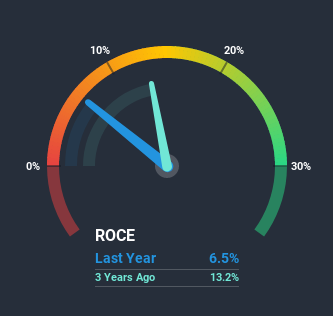Here's What To Make Of McCarthy & Stone's (LON:MCS) Returns On Capital

If we want to find a stock that could multiply over the long term, what are the underlying trends we should look for? In a perfect world, we'd like to see a company investing more capital into its business and ideally the returns earned from that capital are also increasing. Ultimately, this demonstrates that it's a business that is reinvesting profits at increasing rates of return. In light of that, when we looked at McCarthy & Stone (LON:MCS) and its ROCE trend, we weren't exactly thrilled.
Return On Capital Employed (ROCE): What is it?
For those who don't know, ROCE is a measure of a company's yearly pre-tax profit (its return), relative to the capital employed in the business. Analysts use this formula to calculate it for McCarthy & Stone:
Return on Capital Employed = Earnings Before Interest and Tax (EBIT) ÷ (Total Assets - Current Liabilities)
0.065 = UK£51m ÷ (UK£914m - UK£132m) (Based on the trailing twelve months to October 2019).
Thus, McCarthy & Stone has an ROCE of 6.5%. In absolute terms, that's a low return but it's around the Consumer Durables industry average of 7.1%.
View our latest analysis for McCarthy & Stone
In the above chart we have measured McCarthy & Stone's prior ROCE against its prior performance, but the future is arguably more important. If you're interested, you can view the analysts predictions in our free report on analyst forecasts for the company.
So How Is McCarthy & Stone's ROCE Trending?
In terms of McCarthy & Stone's historical ROCE movements, the trend isn't fantastic. To be more specific, ROCE has fallen from 12% over the last five years. Meanwhile, the business is utilizing more capital but this hasn't moved the needle much in terms of sales in the past 12 months, so this could reflect longer term investments. It may take some time before the company starts to see any change in earnings from these investments.
On a side note, McCarthy & Stone has done well to pay down its current liabilities to 14% of total assets. So we could link some of this to the decrease in ROCE. What's more, this can reduce some aspects of risk to the business because now the company's suppliers or short-term creditors are funding less of its operations. Since the business is basically funding more of its operations with it's own money, you could argue this has made the business less efficient at generating ROCE.
What We Can Learn From McCarthy & Stone's ROCE
In summary, McCarthy & Stone is reinvesting funds back into the business for growth but unfortunately it looks like sales haven't increased much just yet. And investors appear hesitant that the trends will pick up because the stock has fallen 43% in the last three years. Therefore based on the analysis done in this article, we don't think McCarthy & Stone has the makings of a multi-bagger.
If you'd like to know about the risks facing McCarthy & Stone, we've discovered 1 warning sign that you should be aware of.
While McCarthy & Stone isn't earning the highest return, check out this free list of companies that are earning high returns on equity with solid balance sheets.
This article by Simply Wall St is general in nature. It does not constitute a recommendation to buy or sell any stock, and does not take account of your objectives, or your financial situation. We aim to bring you long-term focused analysis driven by fundamental data. Note that our analysis may not factor in the latest price-sensitive company announcements or qualitative material. Simply Wall St has no position in any stocks mentioned.
Have feedback on this article? Concerned about the content? Get in touch with us directly. Alternatively, email editorial-team@simplywallst.com.


